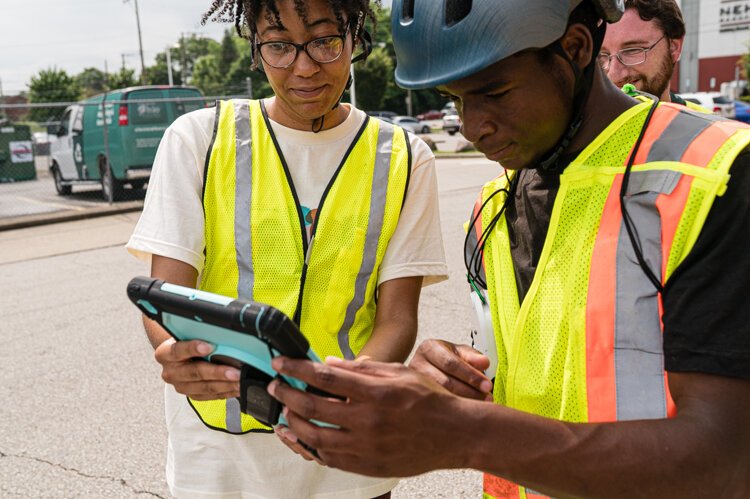Our schools have become a chief source of treatment – and concern – for youth mental health
Schools have become critical places to identify mental health concerns, but they're also a major source of stress.
“Our kids are suffering,” is how one Cincinnati professional summed up the mental health landscape that teens and younger are navigating today. The markers of a healthy emotional life were already trending the wrong way before the pandemic, but the isolation and trauma caused by that event led to a surge in rates of depression, anxiety, and mental health emergencies nationally, including suicide. In 2021, three leading U.S. medical associations declared a national emergency in youth mental health.
It’s an urgent problem, and in Greater Cincinnati, leaders from the medical, social services, education, and philanthropic communities are collaborating to work on the issue. Parents, medical providers, care givers, mental health professionals, and youths themselves will be part of the solution. This story is the third in the Soapbox Cincinnati series, Amplifying Youth Voices, which raises awareness of the problem and looks at possible community-based answers to it.
With the crisis in youth mental health growing, and care either not available or too costly, schools have emerged as the primary sites of care for children in need.
By one estimate, 80% of mental health care for youth is delivered in a school setting. But paradoxically, children often find school to be a source of their problems. And teachers and other school staff, already burdened by growing class sizes, state mandates, and tight budgets, often lack the means to respond appropriately.
A network of support services and community programs has grown to help schools handle the increasing demand for student emotional support, but experts say more is needed.
As mental health issues have reached an epidemic level, it’s become more urgent to identify children who have mental health disorders or are at risk of developing them. It’s estimated that 80% of students with a serious emotional disturbance do not receive the services they need. Failure to receive care can lead to a life of problems, as half of all lifetime cases of mental illness begin by age 14.
Early intervention has become critical and schools have become critical places to do that, as children and adolescents spend much of their lives there. But some students and others say the school environment has become an unrelenting source of stress.
“Our students spend seven hours a day in a school environment. It’s where a lot of the social concerns come up,” says Nicole Pfirman, director of school-based mental health systems at MindPeace. “It’s also where a lot of the triggers are.”
Bullying, stress, and discipline
In focus groups of youth conducted last fall for the local nonprofit agency Interact for Health, many said they experienced bullying, stress, and harsh discipline at their schools, making them environments of dread and anxiety, rather than the nurturing places they should be.
As one local teen told a focus group:*
“I know a lot of my friends don’t want to wake up and go to school. I think that if it was more supportive and people felt like it was a safe and comfortable [place] to go, then it would be a better time.” –T., White male, 15-18
Bullying has long been a corrosive aspect of school, but the pervasiveness of social media has magnified it, providing a 24-hour a day venue for the provocations, judgments, and ostracism that kids can engage in. Nearly one in five students in Ohio reported bullying on school property in a 2021 study.
“The impact of technology on kids’ lives is huge,” says Dr. Suzanne Sampang, director of child and adolescent psychiatry at Cincinnati Children’s Hospital Medical Center. “Bullying, which used to only happen during the school day is now 24-7, and it can be in multiple different forms.”
“Some rumors started and me and my friend both kind of experienced cancel culture… We were receiving death threats… Being on the other side of [the rumor] was definitely a different perspective and difficult to go through.” – A., White female, <15
Students, teachers, and other professionals also report that schools have become high-pressure arenas, as competition among students has increased, parents have their eyes on college admissions, and teachers and administrators push for improvements on state-mandated scorecards of performance.
“Something we’ve seen in education over the last 10 years is the high level of perfectionism that students are experiencing,” says Pfirman, who worked in Mason City Schools for 19 years as a therapist and special services supervisor.
MindPeace collaborated with experts from Cincinnati Children’s, local mental health nonprofit 1N5, and other organizations on an as-yet-unpublished study that assessed levels of anxiety and depression in high school students at several local school districts over the last five years. The researchers expected to see the impact of social media or family issues as the student’s top anxiety triggers, but the study found something else.
“What we’ve seen is that pressure from self is the highest level of concern when it comes to anxiety and depression in high schoolers,” she says. “When you really looked at the ranking that the students themselves did, the first 10 to 15 were related to how much pressure they put on themselves to perform,” she says.
Her observations are backed up by a study that found that suicide attempts and emergency-level mental health crises were highest when students begin a new term and when state-mandated tests are about to begin.
One student expressed the frustration of coping with classwork demands:
“I feel like teachers… they’re assigning homework and all this stuff, and you have to study for the test the next day, but like, you have six other classes and teachers doing the same exact thing. It just piles up. So just if teachers and just like people [were] more understanding… we don’t work [in a paying job], but we go through the same stuff, too.” –M., African American female, 15-18

Stress, pressure to perform, and bullying can lead to anger and emotional outbursts if not relieved or handled properly. Unfortunately, teachers and staff, already strained by heavy workloads, pressure to “catch up” from the pandemic lull in schooling, and ever more burdensome state mandates, often don’t have the time or training to respond in ways that are helpful to the student.
Teachers may respond with punishment and discipline, escalating the issues rather than calming them. That can be especially true for Black students. A 2022 study by the American Civil Liberties Union of Ohio found that black students in Cincinnati Public Schools are six times more likely to receive out-of-school suspensions; eight times more likely to be expelled without instruction; and five times more likely to face emergency removals from school. “Cincinnati Public Schools’ discipline scheme and policing program has horrific effects on the well-being of students,” the report concluded. “CPS should end its reliance on school police and exclusionary discipline and instead invest in proven, preventative mental health and support services.” Cincinnati Public revised its code of conduct last year to address some of these concerns.
Although most schools have psychologists and counselors on staff, their roles are not to provide mental health treatment, but to assess and evaluate students to determine if they need special services and individualized education plans.
Teachers and other staff, despite best intentions, are often overworked, with new requirements placed on them every year, making it difficult to detect and respond to signals of mental health decline in their students.
“It’s a school building full of kids who are depressed. They [adults] say ‘you can talk to me’ but then [they] don’t come across as someone that you can talk to. They’ll say that the first day of school, and then after that, they’re the cause of half of the issues you have.” –M., African American female, 15-18
This lack of awareness can result in a deepening of a mental health issue or an emergency.
One student’s experience
Sarah Mahoney’s daughter, Kate, a freshman at a Cincinnati high school, is considered “twice exceptional,” meaning she is both gifted and challenged, in her case with a form of autism. She is considered neurodivergent, meaning she experiences the world differently from most. She is extremely sensitive to noise, and persistent loud noise can overwhelm her, cause her to shout out, make repetitive motions, or just shut down. She wears noise buffers, similar to noise-cancelling headphones, to reduce ambient noise. Her school-approved education plan permits her to leave her classes a few moments early to avoid the crush of students in the halls changing classes. But recently a school security officer asked why she was in the hall before classes were out. Rather than accept her explanation and check on it later, he challenged her, and eventually escorted her to the school office. Although Kate was already showing signs of shutting down and becoming overwhelmed by the situation, the office staff asked her to call her mother rather than doing it themselves. She was able to call on her mobile phone, but when mom answered, Kate was unable to tell her what was going on.
“All she was able to say was ‘Mom,’ and she’s crying,” Sarah says. “So my mind goes to the worst thing. She’s not able to talk and she’s not able to tell me that she’s with someone or what happened.” It was a crisis that should never have happened.
“I don’t feel like there’s enough training provided for security or for teachers on how to deal with neurodivergent children and children with mental health issues,” Sarah says.
Not only have mental health issues become more prevalent, they have become more severe, says MindPeace’s Pfirman. “I think what we’re seeing now in terms of demand in schools is the intensity crisis,” she says. “The more intense cases mean more work, and that is a strain on the system that I think we’re not quite able to meet yet.”
Filling the gaps
Schools have turned to private providers of mental health services to fill the gaps.
MindPeace is a collaborative learning network that oversees about 220 school mental health partnerships in 26 school districts in Greater Cincinnati. MindPeace professionals assess the mental health needs of a school, the demographics, the insurance status of the families, and then reaches out to a network of providers to see which ones can provide services for the school community. MindPeace staff then stay involved as links between the providers, the school staff, and the community to help navigate the system, see that referrals are made, and gather information on how the process is working.
“The idea of MindPeace is to ensure that there’s a system of mental health care that all students can access,” Pfirman says.
MindPeace has also created calming rooms in about 50 schools where students can go to regulate their emotions before they face a triggering event, during such an event, or afterward. Low lighting, soft music, and comfortable furniture are meant to provide an environment that can help students cope with the stresses of school. “They can go to these spaces and engage in four or five activities that help to build resiliency skills and coping strategies,” Pfirman says. “The idea is to build the skills that you’ll need when you are in a crisis situation.”

Children’s Hospital mental health professionals are currently in 59 schools in nine public school districts around Greater Cincinnati, and in three private schools. “We have 88 clinical therapists or clinical counselors who are embedded in the schools,” says Emily Meyer, who leads the school-based therapist program at Children’s. “They’re available to see patients the same way that our outpatient mental health providers would, but they see them within the school setting,” she says.
“The need is greater now than ever before,” she says. “We’ve continued to grow to meet that need.”
Providing care in the school buildings can help deliver treatment in a timely way. “There’s a lot of barriers to care when it’s provided in an outpatient setting,” Meyer says. “It might be transportation, parents, or job schedules that can get in the way of getting children to appointments. So school-based mental health provides mental health care where the kids are and where they primarily live their lives.”
Cincinnati Public Schools has a “mental health partner” in each of its 65 school buildings, says Yejide Mack, the district’s director of positive school culture. “Everyone has someone present in their building to refer to when students need additional supports,” she says.
The district also has a “positive behavior intervention and supports team” in each of its buildings, Mack says. “We teach students how to read, we teach students how to do math, we teach students how to speak, but we need to teach them how to behave appropriately in social situations,” she says.
In the last year, the Cincinnati district updated its code of conduct to emphasize “restorative practices” as alternatives to traditional disciplinary practices, which often result in suspensions or expulsions, and can begin a cycle that ends in dropping out or even incarceration. Restorative practices emphasize resolving conflict, repairing harm, and healing relationships, and are believed to reduce bullying and out-of-school discipline.
“If we are helping to address the root cause of student misbehavior, it will also reduce the exclusionary consequences,” Mack says.
Some schools are training students to talk to each other to identify and communicate the stressors in their lives. Middle school and high school students in the Talawanda School District in Oxford, Ohio, for example, have formed youth-led prevention teams and are being trained in active listening and strategies for gathering information from their peers about their health and safety.
Progress is being made, but much more remains to be done to improve the environment in schools. Some have called for universal mental health screening in schools, noting that detecting problems early can help prevent them from becoming severe later.
But that takes training and funding, and many public school districts are already financially strapped. MindPeace’s Pfirman says policy makers need to be engaged. “I think there is a huge need for advocacy at the state and federal levels for policy changes in the educational sector,” she says. “There is a need for advocacy for funding so that schools feel like they have the financial support to put some of these systems in place.”
There are no quick fixes. In fact, the answers may lie in a reimagining of the entire school environment to create surroundings that are more compassionate and less stressed.
“What are the systems that are leading to student mental health concerns?” Pfirman says. “A lot of them are the policies that have been in place for 25 years and need to be adjusted. Student wellness has to be at the forefront of everything we do moving forward. It really is the only way to get out of this crisis.”
*Cincinnati consulting firm Cohear conducted seven focus groups with 58 young people and their families from Greater Cincinnati in September-November 2023.
READ MORE: Collective action emerges on the crisis in youth mental health
READ MORE: Finding and affording mental health care is a struggle for many families and children
The Amplifying Youth Voices series is made possible with support from Interact for Health. To learn more about Interact for Health’s commitment to mental health and well-being, please visit here.

















